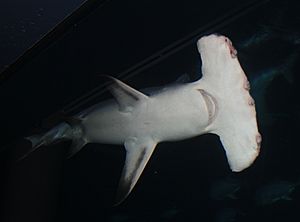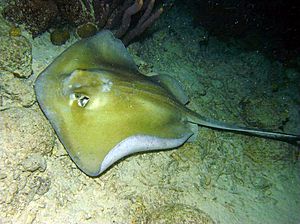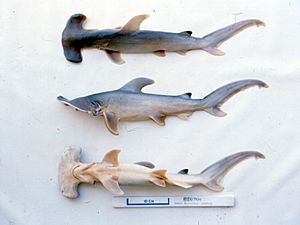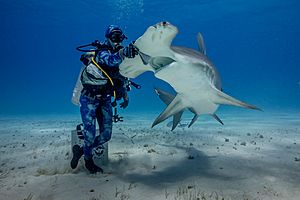Great hammerhead facts for kids
Quick facts for kids Great hammerhead |
|
|---|---|
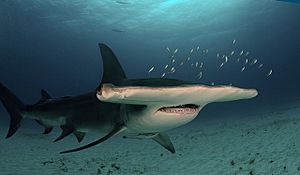 |
|
| Conservation status | |
| Scientific classification | |
| Genus: |
Sphyrna
|
| Species: |
mokarran
|
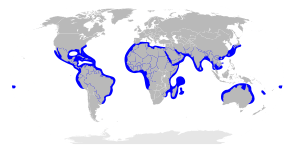 |
|
| Range of the great hammerhead | |
| Synonyms | |
|
Sphyrna ligo Fraser-Brunner, 1950 |
|
The great hammerhead (Sphyrna mokarran) is the biggest type of hammerhead shark. It can grow to an average length of about 4.6 meters (15 feet). Some can even reach up to 6.1 meters (20 feet) long! You can find these sharks in warm, tropical waters all over the world. They live near coastlines and along the edges of continental shelfs.
You can tell a great hammerhead apart from other hammerheads by its unique "hammer" shaped head. This head is called a "cephalofoil." It's very wide with a nearly straight front edge. They also have a tall, curved first dorsal fin. Great hammerheads are strong swimmers and usually hunt alone. They are apex predators, meaning they are at the top of their food chain. They eat many different things, like crustaceans, cephalopods (like squid), bony fish, and even smaller sharks. Scientists have seen them use their hammer-shaped heads to pin down stingrays, which they love to eat!
Female great hammerheads give birth to live young, usually up to 55 pups, every two years. Even though they are big and powerful, great hammerheads rarely attack humans. They can sometimes be curious about divers, so it's important to treat them with respect. Sadly, these sharks are heavily fished for their large fins. These fins are very valuable in Asia for shark fin soup. Because of this, the number of great hammerheads is dropping quickly around the world. In 2019, the International Union for the Conservation of Nature (IUCN) listed them as Critically Endangered. This means they are at a very high risk of disappearing forever.
Contents
What is a Great Hammerhead Shark?
The great hammerhead shark is the largest species of hammerhead. It's known for its distinctive head shape, which looks like a wide, flat hammer. This unique head helps the shark in many ways, especially when hunting. These sharks are powerful swimmers and can be found in warm oceans worldwide.
Where Do Great Hammerheads Live?
Great hammerheads live in tropical waters across the globe. You can find them between 40 degrees North and 37 degrees South latitude. This includes areas like the Atlantic Ocean, Indian Ocean, and Pacific Ocean. They are found from places like North Carolina to Uruguay and from Morocco to Senegal. They also live around Australia, New Caledonia, and French Polynesia.
These sharks can live in shallow waters, less than 1 meter (3 feet) deep. They also go into deeper waters, up to 80 meters (260 feet) offshore. They especially like coral reefs. They also live on continental shelfs, near islands, and in lagoons. Great hammerheads are migratory. This means they travel long distances. For example, sharks off Florida move closer to the poles in the summer.
What Do Great Hammerheads Look Like?
The great hammerhead has a sleek body and its famous "hammer" head. This head is called a cephalofoil. Adult great hammerheads have a cephalofoil with a nearly straight front edge. It also has small dips in the middle and on the sides. The width of this "hammer" is about 23-27% of the shark's total body length.
Their teeth are shaped like triangles and have jagged edges. The teeth become more slanted towards the corners of their mouth. They have many rows of teeth, perfect for catching prey.
The first dorsal fin is very tall and curved like a sickle. It starts right above where their pectoral fins are. Their second dorsal fin and anal fin are also quite large. The pelvic fins are curved, unlike the straight ones on some other hammerheads. Their skin is covered in tiny, diamond-shaped scales called dermal denticles.
Great hammerheads are dark brown, light gray, or olive green on top. Their underside is white. Adult sharks usually have plain fins. Young sharks might have a dark tip on their second dorsal fin.
The average great hammerhead is about 3.5 meters (11.5 feet) long and weighs over 230 kilograms (500 pounds). Some, mostly females, are much larger. The longest great hammerhead ever recorded was 6.1 meters (20 feet) long. The heaviest known great hammerhead was a female caught in 2006. She was 4.4 meters (14.4 feet) long and weighed 580 kilograms (1,280 pounds). She was so heavy because she was pregnant with 55 pups!
How Do Great Hammerheads Live?
Great hammerheads are usually solitary hunters. They tend to stay away from other reef sharks. If another shark gets too close, they might show an agonistic display. This means they drop their pectoral fins and swim in a stiff way to warn the other shark.
Young great hammerheads can be eaten by larger sharks, like bull sharks. But adult great hammerheads don't have many predators, except for killer whales. Sometimes, yellow jacks rub against the hammerhead's sides. They might be trying to get rid of parasites. Schools of pilot fish sometimes swim along with great hammerheads.
What Do Great Hammerheads Eat?
The great hammerhead shark is an active hunter with a varied diet. They eat many different things. This includes invertebrates like crabs, lobsters, squid, and octopus. They also eat many types of bony fish. Some examples are tarpon, sardines, sea catfish, toadfish, porgies, and groupers. They even eat smaller sharks like smoothhounds.
Great hammerheads are expert hunters of other sharks, rays, and skates. They especially love stingrays. It's common to find venomous stingray spines stuck in their mouths. But these spines don't seem to bother the shark. One shark caught off Florida had 96 spines in and around its mouth!
These sharks usually hunt at dawn or dusk. They swing their heads widely over the seafloor. This helps them find stingrays buried in the sand. They use special sensors on the underside of their "hammer" to detect the stingrays' electrical signals. The "hammer" also helps the shark turn quickly to strike the ray once it's found.
Scientists have seen a great hammerhead attack a southern stingray in the Bahamas. The shark first hit the ray hard with its head. Then it pinned the ray to the bottom with its head. It then took large bites from each side of the ray. This crippled the stingray, making it easy for the shark to eat. This shows that the great hammerhead tries to disable its prey first. This is similar to how a great white shark hunts. The "hammer" head is a special adaptation that helps them handle their prey.
How Do Great Hammerheads Swim?
A study in 2016 showed that great hammerhead sharks save energy by swimming on their side. This is called "rolled swimming." The shark uses its very large dorsal fin to help it lift in the water. They might spend up to 90% of their time swimming this way. This technique is thought to save about 10% of their energy.
Life Cycle and Reproduction
Like other hammerhead sharks, great hammerheads give birth to live young. This is called viviparity. The young sharks develop inside the mother. Once they use up their yolk supply, a structure like a human placenta forms. This connects the young to the mother.
Unlike most sharks, great hammerheads have been seen mating near the surface of the water. Females breed once every two years. They give birth in late spring to summer in the Northern Hemisphere. In Australia, they give birth from December to January. The gestation period (how long they are pregnant) is 11 months.
A female can give birth to 6 to 55 pups at a time. Usually, they have 20 to 40 pups. The young sharks are about 50-70 centimeters (20-28 inches) long when they are born. Males become mature when they are about 2.3-2.8 meters (7.5-9.2 feet) long. Females mature when they are about 2.5-3.0 meters (8.2-9.8 feet) long. Young sharks have a more rounded head than adults. Great hammerheads usually live for 20-30 years. The record-holding female from Boca Grande was thought to be 40-50 years old!
Great Hammerheads and Humans
Because of their large size and sharp teeth, great hammerheads could seriously hurt a human. So, it's important to be careful around them. This species has a reputation for being aggressive, but divers often report that great hammerheads are shy or don't react to humans. However, there have been reports of them coming very close to divers.
The International Shark Attack File has recorded 34 bites from hammerhead sharks. 17 of these were unprovoked, and none were deadly. It's hard to know how many were caused by great hammerheads specifically. This shark has only been confirmed to be responsible for one bite, which was provoked.
Great hammerheads are often caught by both commercial and recreational fishermen. They are caught using longlines, nets, and hooks. People usually don't eat their meat. But their fins are very valuable for shark fin soup in Asia. Their skin is also used for leather, their shark liver oil for vitamins, and their bodies for fishmeal. Great hammerheads are also often caught by accident (called bycatch). Many of them die from this, with over 90% mortality in some fisheries. They also get tangled in shark nets near beaches in Australia and South Africa.
In Queensland, Australia, it is against the rules for recreational fishers to catch any hammerhead species. In other parts of northern Australia, catching great hammerheads is allowed. In the Bahama Islands, feeding great hammerheads helps bring in over $100 million in tourism each year. This also helps protect sharks in the waters around the islands.
Protecting Great Hammerhead Sharks
The great hammerhead is very sensitive to overfishing. This is because there aren't many of them, and they take a long time to reproduce. It's hard to know exactly how many there are because fishermen often don't separate them from other hammerheads in their reports.
This species is listed as globally Endangered on the IUCN Red List. This means they are at high risk of extinction. In the northwestern Atlantic and the Gulf of Mexico, their numbers have dropped by 50% since the 1990s. This is mainly due to being caught as bycatch. They are also Endangered in the southwestern Indian Ocean. Here, many boats fish illegally for hammerheads.
The number of great hammerheads caught in the Indian Ocean dropped by 73% from 1978 to 2003. Along the western coast of Africa, their numbers have fallen by an estimated 80% in the last 25 years. The West African Sub-Regional Fishing Commission (SRFC) says the great hammerhead is one of the four most threatened species in the area. But fishing continues without being watched or controlled. Off northern Australia, this species is at "high risk." There's a growing concern about illegal fishing because the value of their fins is rising.
Currently, there are no specific rules just for protecting the great hammerhead. However, banning shark finning by countries like the United States, Australia, and the European Union should help. International groups like the International Commission for the Conservation of Atlantic Tunas (ICCAT) are also working to reduce fishing pressure.
A study in 2021 in the journal Nature looked at 31 species of sharks and rays. It found that the number of these species in open oceans had dropped by 71% in about 50 years. The great hammerhead was one of the species included in this study.
Images for kids
See also
 In Spanish: Tiburón martillo gigante para niños
In Spanish: Tiburón martillo gigante para niños



